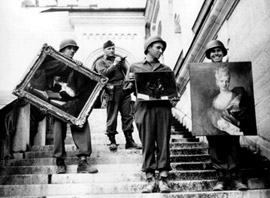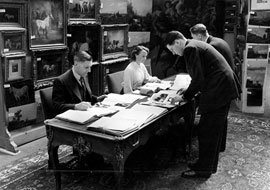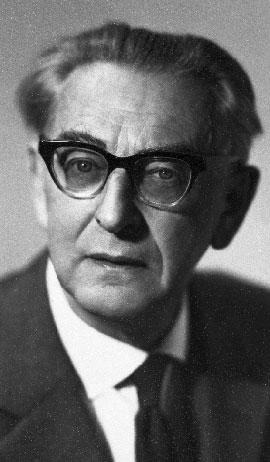Salzbergwerk Altaussee
To protect the artworks intended for the “Führer Museum” against aerial attacks, some of them were removed from Munich to the salt mine at Altaussee starting in May 1944. In the final days of the war, Nazi district leader August Eigruber (1907–1947) ordered the storeroom to be blown up, but this was prevented by several courageous miners.
See:

Schloss Neuschwanstein
American troops discovered one of the largest storage facilities of looted artworks at the Neuschwanstein Castle in 1945. Art objects of all kinds were stored there, all looted in Paris by the "Einsatzstab Reichsleiter Rosenberg," the most effective Nazi looting organization.
See:
Gershom Scholem (1897-1982)
Numerous Jewish scholars temporarily worked at the Offenbach Archival Depot to assist in the identification of books and manuscripts. One of them was Gershom Scholem, who attempted to have unrestitutable books sent to Jerusalem on behalf of the Jewish National and University Library.
See:

Franz Alfred Six (1909-1975)
Within the Security Service (later: Reich Security Head Office), press specialist Franz Alfred Six was responsible for "opposition research." Wherein he pressed ahead with the establishment of the Jewish Library. Sentenced to 20 years prison at the Nuremberg trials, he was released in 1952 and worked subsequently as advertising director for Porsche Diesel Motorenbau GmbH in Friedrichshafen."Sonderauftrag Linz" ("Special Mission Linz")/"Führer Museum"
Adolf Hitler saw himself as the ultimate judge and benefactor of the arts in the German Reich. He fought modern art and viewed himself as a promoter of realism and classicism as artistic styles. His enthusiastic reception in his home town Linz on March 13, 1938 resulted in the idea to donate a painting gallery to the town. The confiscation of Jewish art collections in Austria provided an opportunity to expand this "Führer Museum" into a gallery of Old Masters that would rank among the top museums in Europe.
The "Special Mission Linz" first selected confiscated artworks from Austria and then from all of Europe for the "Führer Museum." It also decided which museums would benefit from the confiscations.
See:

Stichting Nederlands Kunstbezit (SNK)
The Netherlands established the Stichting Nederlands Kunstbezit, the dutch Restitution Commission, in June 1945. In 1950, the Commission organized an exhibition at the Rijksmuseum in Amsterdam, where looted art returned from Germany was shown. It served the purpose of enabling owners to identify looted artwork. Owners could immediately file a claim for restitution on the spot. The work of the SNK has come under heavy criticism during the 1990s, and subsequently was subjected to a profound research.
Ferdinand Stuttmann (1897-1968)
Stuttmann, from 1937 to 1962 director of the art gallery at the Landesmuseum in Hanover, served as an art appraiser, charged with the evaluation of confiscated collections. Although fully aware of their dubious provenance, in 1949 he purchased 100 objects from the Doebbeke Collection, compiled in the Nazi era from confiscated Jewish collections.
See:





